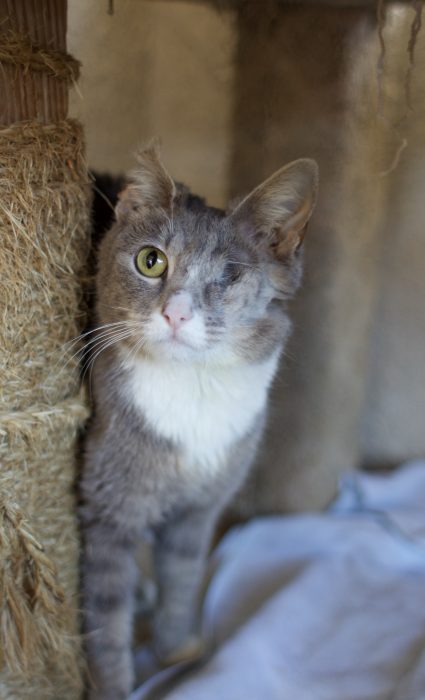
Bringing Your New Cat Home
It’s a big world out there! Your new cat may have been at our kennel for a few months or even years, or only for a week or two. In any case, your home is a new world and a LOT bigger than what she has been accustomed to. It can be overwhelming.
For this reason, we offer the following suggestions:
- Introduce your new cat to one room at a time.
- Until your cat feels comfortable, you may want to confine her to one room.
- Be with your cat as she explores the new surroundings; this will help her to not feel so frightened and to help set boundaries as to just where she can go.
- Show your cat where the litter box will be kept and place her gently into it for a moment.
- Show your cat where the food bowls will be (have fresh water and food in the bowls when you do this).
- Avoid loud noises – this will most certainly frighten your cat any time, but especially when she is not yet comfortable in the new home.
- Talk, talk, talk.. Your new cat will be soothed by your gentle voice.
If you have another cat in your home:
- Keep your new cat in a separate room from your resident cat. Rub small towels against each of the cats, and leave each scented towel with the other cat.
- Be sure to show ample (or even more) attention to your resident cat so she does not feel left out or resentful toward the new addition.
- Have supervised and limited interaction between the resident cat and your new cat.
- Depending on how the cats interact with each other, you may need to keep the separation period for as little as a few days or for as long as two weeks or more.
- We all want our pets to be the best of friends. This is not the case in all situations, and sometimes the best scenario is that they will simply “tolerate” each other.
- Above all – please BE PATIENT while everyone is going through the adjustment period.
New Cat Supplies
- Litter pans – We suggest 1 litter pan per cat/kitten. Size is important. If you are bringing home a kitten, you will want to start with a small litter pan; increase the size of the litter pan as your kitten grows, depending on how big he or she gets. Your cat needs ample room to “scratch and dig” and to relieve himself or herself comfortably without eliminating over the sides of the litter pan. World’s Best Litter is a natural, non-toxic brand of litter and “clumps” very well. (Particularly recommended for kittens whose little lungs can be more sensitive to the dust of clay litter.) Another good clumping litter is Tidy Cat and can be found in most all supermarkets as well as pet stores. Note that not all cat litter is “flushable.”
- Scoopers – Litter pan scoopers to “scoop” the waste from the litter pan. Scoop as needed, at minimum twice per day, more often for multiple-cat households. Litter pans should be emptied and thoroughly washed once or twice per week depending on usage and number of cats. Simple Green brand cleaner is non-toxic and biodegradable and can be diluted with hot water to wash out the litter pan.
- Food and Water Bowls – Stainless steel, ceramic, or glass are best. Plastic bowls hold in bacteria, can cause feline acne, and are not recommended.
- Quality Food – Wellness canned (most are grain-free) and dry food are a good example of quality food for a standard diet. Others can be found in pet stores such as Petco, Centinela Pet and Feed, or Pet Depots. Typically the staff at these stores are knowledgeable and helpful. If your pet has dietary restrictions, prescription diets can be found at your vet’s office.
- FRESH Water – Water (NOT milk) is vital to cats’ well-being. Always have fresh water available. Consider using filtered water.
- Wire Brush and Comb – Cats and kittens love to be brushed and combed. If they are frightened at first, slowly introduce brushing into their daily routine. Even if this means only one stroke. Once your cat is comfortable with you and knows that the brush and comb are good things, this routine will provide wonderful bonding time for both of you as well as promote a healthy, shiny coat, and reduce dander, shedding, and hairballs. Regular brushing is critical if you have a long- or medium-haired cat. Without regular brushing, knots or mats can form close to the skin and be extremely painful to your pet. If the knots or mats cannot be combed out, the pet will need to be shaved.
- Hairball Remedies – Since cats and kittens are fastidious groomers, they can ingest a lot of hair, even with regular brushing. A good, natural remedy to help them eliminate hairballs is “kitty grass”. You can find “kitty grass” at most supermarkets and just about every pet store. Another alternative is Petromalt, an intestinal lubricant that comes in a tasty paste and aids in hairball prevention and elimination. A veterinarian may give specific directions regarding Petromalt dosage. Follow your veterinarian’s advice closely. Hairballs are generally more common in adult cats than young kittens.
- Scratching Posts – Let’s face it, cats and kittens love to scratch; it is a healthy and a natural instinct for them. Declawing your cat is NOT an option. It is inhumane, as well as a violation of your contract with us. Having a couple of durable, sturdy scratching posts will not only make your cat or kitten very happy, it can also help to deter unwanted scratching on your furniture. Be sure to show your new cat the scratching posts. Gently put her front paws on the scratching post and be sure to praise her for using it.
- Kitty Perches and Condos – Some cats and kittens love a bird’s eye view to survey their surroundings. Be sure it is sturdy and will not tip over if your cat jumps on or off the perch.
Toys, Toys and TOYS – Cats and kittens love to play with toys. Little catnip mice or glitter balls are great to toss around for them to chase and pounce. Feather poles are another fun and interactive way for you and your cat to engage in play time. This is also very stimulating for your cat. Be careful of small toys or toys with loose parts that your pet can accidentally ingest. - Catnip – A sprinkle of fresh catnip every now and then is always a fun treat for kitty.
- Nail Trimming – Even with ample scratching on a scratching post, your cat’s nails will require periodic trimming, averaging once every 4 to 6 weeks. You can do it yourself or take your dog to your vet’s office or groomer for routine nail trimming.
- Flea Preventative – Fleas multiply rapidly and quickly and can spread from pet to pet; if you have any suspicion that your pet has fleas, contact your veterinarian immediately to determine the best treatment for your pet. Flea preventative is recommended on a case-by-case basis. We suggest using Comfortis (pill) or Frontline (topical). Please make sure whatever product you use is safe for cats. Some dog-specific flea preventatives are extremely toxic to cats.
Reasons you may need to use a flea control product:
- if you have a dog. Since dogs go outside regularly, there is a likely chance that your dog could be exposed to fleas.
- if you work or play outside or in a garden. Fleas can be brought in on your own shoes or clothes.
- if you like to walk on the beach. The beach can harbor sand fleas.
- if you care for a colony of feral cats. (May we add a special thank you if you do this!)
How to tell if your cat has fleas:
- An unusual amount of scratching, biting and licking
- Bumps on the skin (could mean an allergy to a flea bite)
- Tiny droplets of blood in the food or water bowl
- White worms near the cat’s anal area.
- Flea infestation is not only very uncomfortable for your pet, it can lead to her developing worms and other more serious issues if left untreated.
Quality Vet Care
- All of the kittens and cats that come into our kennel are tested for the FELV (Feline Leukemia Virus) and the FIV (Feline Immunodeficiency Virus).
- Kittens require 3 rounds of shots (given at different stages).
Provided your cat shows no signs of ill health, annual check-ups should be sufficient. - If you don’t currently have a vet, make it a priority to find one that you trust.
- Establish a relationship between you, your pet, and your vet while your pet is healthy; do not wait until your pet is sick and needs medical attention to find a quality vet.
- Know the address of your closest 24-hour veterinary emergency hospital and keep their phone number handy.
